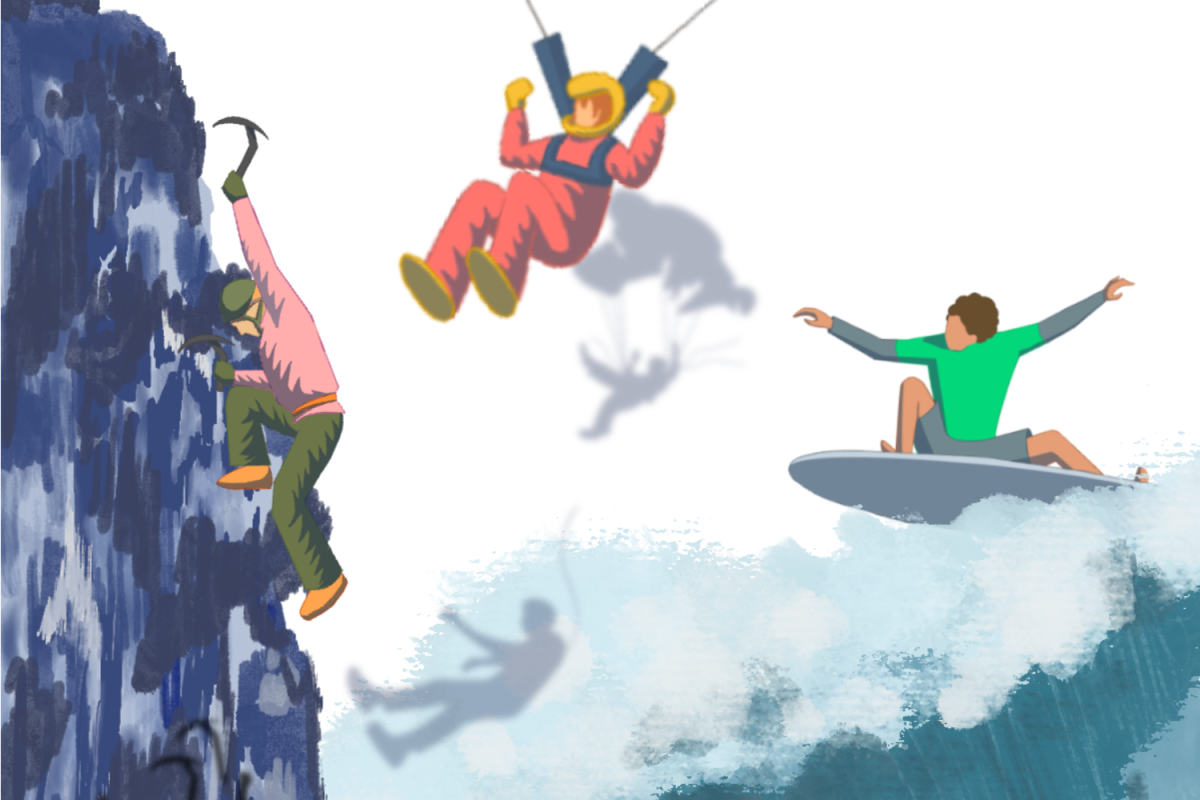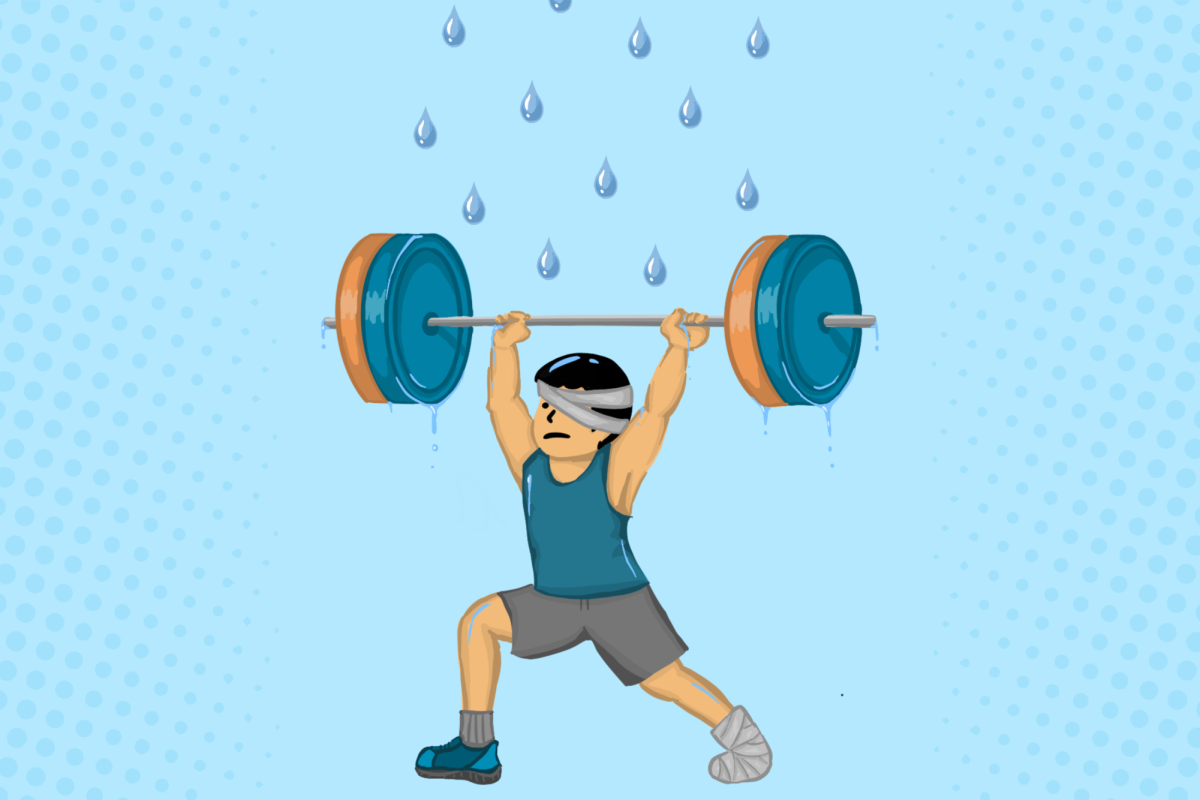Diving off planes, exploring deep seas, cycling through dense forests — thrilling adventures that only a few have the confidence to try. Although engaging with extreme sports can be very immersive and enjoyable, it is necessary to properly assess the precautions needed.
Extreme sports is a broad term often used to refer to high-risk physical activities. Factors such as high speed and altitude require participants to have specialized gear and physical effort to be successful. Extreme sports are held in a large variety of different environments.
Rock climbing, for example, can be either indoor or outdoor. Indoor climbing walls are common with new climbers, as it provides a stable area for them to practice techniques, whereas outdoor climbing often requires more safety equipment and expertise. Once athletes begin outdoor climbing, there are many other factors that they consistently have to be aware of. However, beginners still have to be aware of minor injuries, which can cause discomfort in their daily life.
“When I first started climbing, the skin on my hands got all ripped up,” said junior and climber Aiden Young. “The worst injury I’ve gotten was through workout exercises; there’s been times where I just couldn’t move my arm, but it would go away after one day.”
From the high walls of climbing down to the ocean’s waters, another popular sport, surfing, can often be seen. Surfing refers to riding a wave with a board, and can occur on many different types of bodies of water — not only ocean shores. Surfers are constantly checking environmental conditions to ensure their best safety. When tides are too low, they are more likely to hit the seafloor and get injured on rock-hard coral. Recently in California, waves have, on average, grown a foot taller, causing significantly more unpredictable conditions for surfers. Climate change in the last 50 years has caused rough waves as wind patterns alter with the warming atmosphere. When conditions are good, more surfers tend to be out on the waters, but this can be dangerous as the waves become too crowded, causing collisions to happen.
“It’s pretty common for people to wipe out, and their surfboard goes straight at you,” junior and surfer Matthew Tanaka said. “The fins on the board are especially dangerous, because they can cut deep.”
Mountaineering and paragliding are more unconventional and have a high risk of injury or even death. Mountaineering is formally described as ascending mountains, though the definition varies widely between athletes as there are few set rules and regulations. This freedom may cause accidents. Terrain often varies so athletes must develop a number of techniques, such as traveling through snow or climbing with ropes. This requires athletes to carry a lot of gear while going up mountains. They also need to have packable tents and supplies prepared as climbs often take days to complete.
“On the mountain, the glacier condition changes rapidly, and it is very difficult to predict conditions,” mountaineer Zhong Wang said. “I once encountered an avalanche during a climb. I was fortunate that it was a powder one, but it was still very scary.”
Above these mountains, paragliders can be found exploring the skies with a light-weight gliding device. They control the wing using suspension lines. Hanging beneath the wing, the pilot sits in a harness, pulling on yaw strings. When conditions are suitable, athletes can glide for hours on end. Depending on the height of the flight, injuries from accidents may be deadly.
“It is possible to lose friends from accidents when you’re into these types of sports,” paraglider David Lehr said. “Sometimes, friends would come back with severe injuries from flights. What I did was try out each sport while staying clear of those very, very dangerous sections of each.”
With such high risk for accidents, people must be aware of hazards of the sport they participate in. Precautions should be taken through proper research about not only the physical and mental requirements but also the environment. Constantly changing conditions can make many people overconfident to the point that they become oblivious to the very real dangers of these sports.
Physical health and abilities must match the requirements for the sport, therefore participants must consistently train and condition their body to be able to take on the challenges of extreme sports. Consistent exercise reduces an athlete’s risk for injuries and strengthens bones and muscles. In addition, many participants of extreme sports are adults, so the physical activity needed to train for extreme sports can be a great way to add motivation to exercise more often. However, if those exercises are done in an unfamiliar and risky manner, they can have long-term effects.
Physical environments are significantly more dangerous, which could lead to drastic falls and injuries: trapped under thick layers of snow or high in the mountains where only helicopters are capable of reaching. There’s a much higher risk of permanent injuries that can affect someone’s life in the future. It can even completely change an athlete’s ability to participate in the things that they enjoy.
“Going from somebody who used to be able to take a 20-mile backpacking trip to somebody who now can’t walk more than three miles in a day has been really tough,” Lehr said.
Athletes who are willing to participate and enjoy extreme sports should be properly educated about the risks that come with the activity.
“You have to go into extreme sports with open eyes, understand that you’re putting yourself at high risk of injury and assess whether or not it’s worth the potential consequences,” Lehr said.










































































